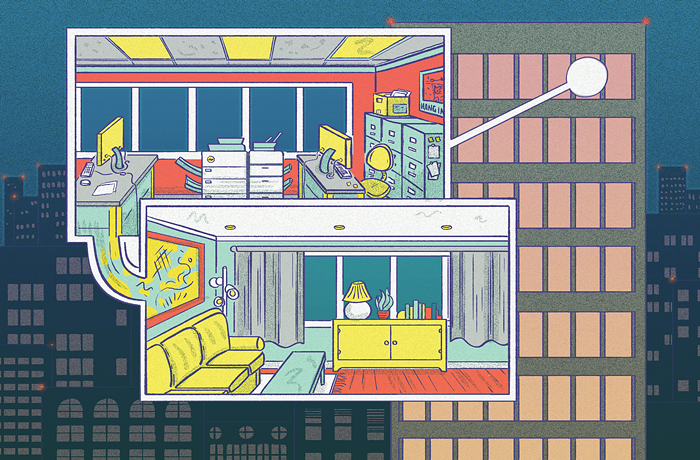I'VE FOLLOWED the simple instructions from the pamphlet "Beginners' Guide to Floating."
"Don't shave or wax before." Check. "Eat a small meal one-and-a-half hours prior." All right. "Don't drink caffeine before." Done.
I'm east of SE 44th on Hawthorne, and the first window I come to is covered with a starburst tie-dye tapestry. Subsequent panes are so thick with condensation they might as well be too—displaying only smudges of bright movement inside.
This must be the place. "Float On" reads the steamy door.
I'm here to begin an investigation into sensory deprivation with a 90-minute REST session (or, to forgo acronyms, the "restricted environmental stimulation technique" of sensory deprivation) in one of Float On's four commercial flotation tanks. More specifically, I'm here to better understand the relationship between creativity and sensory deprivation that's been suggested by an art program hosted onsite, and Float On's resultant book and album, titled Artwork from the Void and Music from the Void, respectively.
Through the outreach programs, Float On gave 150 artists and 30 musicians free sessions, after which each made an original work whilst in the hazy afterglow of sensory deprivation. The book and yet-to-be-released album are documents of those creative experiences.
Pulling open the door of Float On, the humidity's as thick as pink insulation. A turn-of-the-head survey reveals multigenerational faces, all unified in an untalkative calm I'd soon understand. This is the den of the nothing eaters. Couches and bookshelves line the efficient public room, while visual warmth comes in the form of clean hardwood floors and shared tables—those dotted with drawing books and pastries and teacups in various states of use.
At a desk standing behind a computer monitor is a man who speaks before I can say anything—"Hello, Matt"—as if he's known me for years and been waiting for this moment.
He is Christopher Messer. Sensory-deprivation enthusiast of 40 years and one of the four owners of Float On—a man who's been chasing the void since the crude beginnings of contemporary sensory deprivation, the days of cotton balls under fingernails and 24-hour stints in darkened rooms. If there's anyone to give me a crash course in what I'm about to go through, it's him.
"Is this your first float?" he asks.
"Yes," I answer.
Messer shows me to the last door in a row of private float rooms, each containing a tank, shower, fresh towels, robes, and slippers, as well as soaps, lotions, and other supplies. He explains various aspects of the process, like that the water—filtered thrice between each float—is 40 percent Epsom salt and kept at a skin temperature of 93.5 degrees Fahrenheit. He tells me that a shower comes first, the tank second, and another shower to wash away the salt.
Moments later I'm stepping from the shower and into the dark, black box.
***
I was kinda freaked out by the idea of floating. For me, the terms "sensory deprivation" and "flotation tank" were previously synonymous with and inextricably connected to dark pop-culture images: steeple-fingered scientists behind mirrored windows and men in archaic scuba masks suspended within glass tubes of bubbling green water.
Since John C. Lilly invented the flotation tank in the 1950s—and went on to use the technology in concert with LSD and attempts at dolphin communication—the experience waiting within its dark confines has been associated with earlier, more stressful sensory-deprivation techniques. Consider a passage by Ernest R. Hilgard from the introduction to Clinical and Experimental Restricted Environmental Stimulation: New Developments and Perspectives, discussing pre-flotation experiments with sensory deprivation:
"A student could be isolated for two or three days in a soundproof compartment box with a bed in it. Patterned visual stimulation was reduced through the wearing of translucent goggles as the student lay quietly in bed, and special stimulation from self-induced movements was reduced by wearing cardboard sleeves over arms and hands. Communications between subject and experimenter were made through a headset."
Dr. Peter Suedfeld, one of the world's leading experts on restricted environmental stimulation—who coined the term REST and pioneered much of the significant scientific research in the field—says that his most important discovery regarding sensory deprivation came in illustrating test subjects' overwhelmingly positive emotional response to REST. Or, in Suedfeld's words, "That stimulus reduction is not an aversive experience for most people if they're not made anxious before they enter the environment."
It's a discovery that "came very early in my research," says Suedfeld, "and reduced the early termination rate of subjects to under 5 percent." Ensuring a relaxed, safe environment is a large part of what differentiates float tank-style sensory deprivation from white torture (in which prisoners, under constant light and attenuated sound, are submitted to solitary confinement and therein exposed only to white visual stimulation—white room, guards in white clothes, white rice for meals, etc.). It's all about who has control, as well as the circumstances surrounding the period of isolation and reduced environmental stimulation. If a person is in control of their environment, or believes they're entering into a safe experience, they're more likely to find isolation chambers or flotation tanks enjoyable, if not beneficial across many measures.
And while progress is slow in coming, the public perception of REST and recreational float tank use seems to be improving as more and more commercial float centers sprout up both in Portland and across the globe (with the highest concentration in Sweden). Meanwhile, and at an equal, trudging pace, scientific discoveries surrounding the technology indicate float tanks are a viable option to treat various physical ailments and mental or emotional disorders.
Examples are many. Suedfeld illustrated a strong link between REST and smoking cessation in 53 percent of patients. A study by Dr. Roderick Borrie observed a 25 percent reduction in pain after a patient's first float (a reduction that increased to 33 percent after the third session), as well as patient reports of an increased sense of well being and relaxation, and a decreased sense of stress and anxiety (also observed by Suedfeld and other researchers). Trials conducted by Marianne Barabasz and Arreed Barabasz found REST an effective method in treating eating disorders, producing specific food aversions in obese females, and reducing alcohol consumption.
While there are many measurable, positive effects of REST, examining its link to creativity is a bit tougher than studies involving smoking cessation or weight loss. When people measure creativity, they often do so through subjective, unreliable methods—and to attempt an objective survey requires objective, quantifiable benchmarks.
But significant findings are being made. Perhaps the most common evidence referenced to support a connection between REST and increased creativity is the occurrence of theta brainwaves during float sessions—which have long been associated with creativity, and are experienced most commonly in everyday life when a person is in stage-one sleep. In a paper titled "Differential Effects of Wet and Dry Flotation REST on EEG Frequency and Amplitude," Thomas Fine and other researchers concluded a significant correlation between wet REST (of flotation tanks like those at Float On) and "higher amplitude, theta frequency components."
Meanwhile, experimental researchers Donald G. Forgays (University of Vermont) and Deborah K. Forgays (First University of Rome) found that after an hour of REST, "Float subjects showed significant increases on the Guilford [fluency] test [of creativity] from the pre- to post-float." (The Guilford fluency test measures a person's ability to solve problems from multiple perspectives, simultaneously consider multiple solutions, and produce original approaches therein.)
Additionally, it seems most researchers agree that relaxation plays a key role in a floater's increased feelings of creativity. In an essay by Colin Martindale titled "Biological Bases of Creativity," the author asserts that "Perhaps the most common method used by creators [to achieve a creative mindset] is withdrawal so extreme that it verges on sensory deprivation, a condition that lowers cortical arousal," which coincides with the relaxed, divergent thinking brought about in restricted stimulation environments.
If the word gets out in a city full of creatives like Portland, those seeking a competitive professional edge will soon be exploring flotation REST for its apparent benefits.
***
Over a two-week period I spend nine artificial nights in the fashion of the nothing eater—in the flotation tank. My longest session is for two-and-a-half hours, while all others time in at 90 minutes.
After my first session, I described my float to a colleague via text, trying to explicate how I was initially bored and unsure of what to do with my time, which gave way to bursts of random language and a feeling of "reliving some experience I never committed to memory"—a preoccupation that subsided with the slow-yet-certain appearance of "smears of light like the anti-shadows of passing cars" and the silhouette of an animal's skull morphing into a single candy corn.
The following sessions are each a little different, but not without commonalities. A disoriented sense of time is the most ubiquitous reoccurring theme: after the first half-hour in the tank, a minute could be an hour and an hour could be a minute, and it eventually becomes impossible (and undesirable) to attempt the regulation of time. Additionally, losing the will to think in terms of language was common to many floats (usually after the divining-rod bursts of my brain's mouth). A less common but repeating feature was hallucinations like those described above.
For instance, in one session I find myself entrenched in vibrant, lucid visions: Some are memories, while others are fantasy. Most prominently, I remember posing for a photograph at the Alhambra in Spain, standing inside a stone archway. It sounds unremarkable, but what makes this remembrance so unique is how it came as much in images as it did in emotions and a sense of being situated within the as-it's-happening narrative (as opposed to the feeling of looking back on things). I remember the girl holding the camera—with whom I'd develop an intense relationship over the course of the next year—as a fresh acquaintance, a kindling crush only a few weeks old. The sun is bright and how I got here or where I'll go next is unimportant. It just feels good to know that this amazing woman wants me to be one of 24 exposures on a roll of film. It all comes as a rush, the emotional depth and the Spanish heat—a rush of something I'd forgotten almost entirely. As I'm re-experiencing the moment, immersed, I soon realize that my eyes are wide open and I'm staring into darkness.
But intense, inward experience wasn't the only effect. Notably, after my third session, beer—a once-favorite beverage and pastime—becomes entirely unappealing, along with alcohol in general; a side effect that lasts for weeks after my ninth session. I also noticed a marked increase in my overall sense of well being, while anxiety (which I've been struggling with for years) disappears completely. Additionally, I begin to write creatively for the first time in months, but with an uninhibited ease that I haven't experienced in almost five years. In short, I was astounded by the changes I saw in myself.
And as I learn through discussions with other floaters, these experiences aren't uncommon.
Samantha LaMont, a professional baker and hobbyist painter, might as well be a poster child for the benefits of floating. Now a ritual, weekly floater, she had her first session in February of 2011 as a participant in Float On's artist program, and has since quit smoking, lost 60 pounds following an unexplained, tank-born urge to swim (currently she swims five times a week), while eliminating sugar and alcohol from her diet for several-month stretches; overall, committing herself to feeling good by healthy means.
"I feel like I'm a totally different person," says LaMont, who also reported an influx in creative energy.
Moreover, endorsements for floating have come from some surprising places. One afternoon, sitting on a couch at Float On, I'm introduced to mixed martial artist Pat Healy. Healy currently stands as a regular in the Strikeforce MMA league, and has graced televisions across the world as a participant in the Ultimate Fighting Championship. He floats before his fights and uses the tank to visualize his wins. Other MMA fighters, such as Dave Jansen (who can be seen on MTV2's Bellator league) described floating as a "secret weapon."
And while I also meet a handful of colorful characters—folks studying shamanic medicine or making claims to know how to build power generators that draw from the magnetism of the earth, folks who seem to be attracted to the LSD and dolphin-communication history of the tank—I talk to just as many people who are simply looking for relaxation and the feel-good afterglow of flotation REST.
"Normally my head is several different radio stations playing at once," explains local comic and tattoo artist Levi Greenacres, "three left hands scribbling upside down in overflowing dream journals. An electrician's nightmare of jumbled and sparking wires."
But he says upon his first experience in the tank, he found relief: "With the lack of sensory stimulation to intake and compute, I discovered an inert state of un-ness, the need to think, feel, and feed completely abolished. The quiet in there is total comfort.
"Now during my creative process, when I get stuck or frustrated with arm wrestling with the right line, the right words or colors," Greenacres continues, "I close my eyes and remember that un-ness. Then I will remember the 'vision' I had in the tank... when I was still trying to think hard and noisily in the void.... Once I let go of trying to do anything except be present in the moment, I was rewarded with a picture that summed up how silly I am trying to name and shape all of life. That picture was me, mankind, pink and trembling, frail and arrogant: I saw a flying hot dog."
Other artists didn't report any flying hot dogs, but did corroborate significant post-float effects.
"I wouldn't say that floating has affected my artwork in terms of content, but it does put you in the ideal mindset to create art," says local illustrator Natalie Phillips, who participated in the art program and had an exhibit hanging at Float On for the month of January. "After floating I feel very open and calm, and less prone to distractions. The better I feel emotionally or physically, the better I am able to focus and remain lucid while making something."
And that might be the most levelheaded walk-away message yet. Whether you're a fighter about to beat the crap out of someone in front of a screaming stadium, or an artist reducing humanity to a hot dog, feeling good physically and emotionally can only make daily tasks easier. Despite the tie-dye dressing in the fogged-up windows, between convincing scientific evidence and float anecdotes, the general and creative benefits seem fairly ubiquitous.
None of this is to say that the work is over in proving links between flotation REST and creativity (or that the repeat trials necessary to substantiate experimental research findings have, in all instances, been performed to a point of absolute certainty), or that REST has been fully explored from a medical or neurological standpoint.
And I'm definitely not claiming that everyone who floats is going to stop drinking or lose a ton of weight or get laid like Superman at an I Want to Have Sex with Superman Convention.
It's like this: When people ask me about floating, after describing the benefits I've experienced, I tell them, "At the very least, it's like a blowjob for your body." And like Forrest Gump said, that's all I have to say about that.













